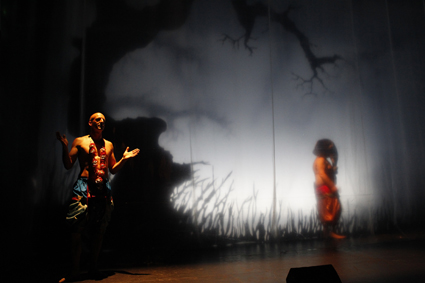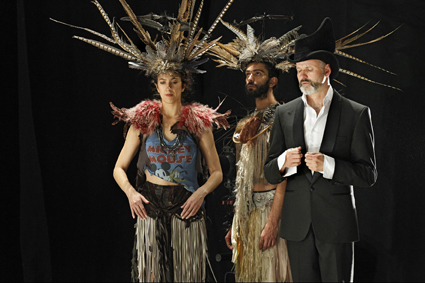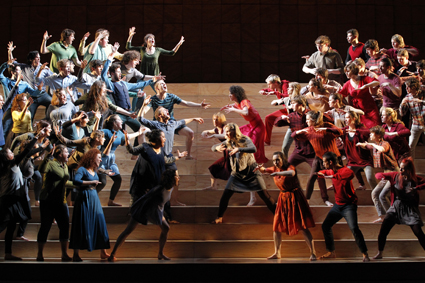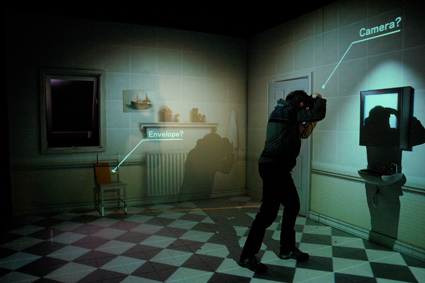bodies, flocks and crowds
john bailey: melbourne international arts festival

Ganesh vs The Third Reich, Back to Back
photo Jeff Busby
Ganesh vs The Third Reich, Back to Back
DISABILITY IN THEATRE IS TOO OFTEN THE ELEPHANT IN THE ROOM. WHILE AN INCREASING NUMBER OF AUSTRALIAN COMPANIES WORKING WITH ARTISTS WITH DISABILITIES HAVE BEEN PRODUCING RICH AND SOPHISTICATED WORK IN RECENT YEARS, IT DOESN’T SEEM THAT A CORRESPONDING DIALOGUE HAS EMERGED OUTSIDE OF THOSE CIRCLES ACTIVELY INVESTED IN SUCH WORK.
Back to Back Theatre is one of the few organisations to have pushed through those invisible barriers, and as latest production Ganesh vs the Third Reich again indicates, the company doesn’t just produce theatre of disability, but theatre about the theatre of disability.
back to back, ganesh vs the third reich
As with previous works such as Small Metal Objects and Food Court, Ganesh… immediately proves itself a complex and provocative engagement with its own audience. A group of actors are rehearsing the titular play, a narrative in which the Hindu god Ganesh voyages to World War II Germany to reclaim the symbol of the swastika from Hitler. It’s a compelling scenario, during which the elephant-headed deity encounters (and bests) the monstrous Dr Mengele, whose pronouncements on physical deformity and eugenics are chilling; an intellectually disabled refugee is on the run from Nazi pursuers; and finally, there’s the leader whose appropriation of the sacred mandala is a brutal theft of cultural identity. All kinds of currents swirl through this fertile play-within-a-play—concepts of power and visibility, voice and silence, nature and transformation. Yet the real energy of the work is located not simply in the narrative itself, but in its enactment and the frame within which it unfolds.
These are actors with perceived disabilities playing actors with perceived disabilities, and it is between these layers of perception that a deeply troubling dynamic arises. David Woods plays the initially benign director shaping the company’s rehearsals, but his real motivations are put on trial as debates arise on the floor over the ethics of representation, the agency of the performers and the necessary inequities of power in a director/actor relationship. It becomes apparent that his desire to work with this company is dependent on a certain selective vision of disability, one which requires a passivity and relinquishing of control to someone socially posited as more authoritative. It’s a question which has been put to Back to Back Theatre itself—what of these productions is created by its performers and what dictated by others? Here the query takes on terrifying urgency, as actors’ failure to comply with their director shifts from hilarious belligerence to emotional vulnerability and, eventually, physical violence. The final sequence is an unforgettable one, in which a man charged with a duty of care commits an act of casual yet devastating betrayal, leaving a performer with a promise that will never be fulfilled.
The implication of the audience in all of this adds a further layer of excruciating tension. At one point an imaginary audience is addressed and questioned on its reasons for attending. How is this act of voyeurism any more than prurient freak porn? Are we, too, demanding a certain kind of theatre of disability for ultimately selfish purposes? And when we leave the theatre, too, what promises have we made with no intention of keeping?
balletlab, aviary

Brooke Stamp, Daniel Jaber, Phillip Adams, Aviary, Balletlab
photo Jeff Busby
Brooke Stamp, Daniel Jaber, Phillip Adams, Aviary, Balletlab
Dynamics of power, authority and observations are also the motors driving Phillip Adams’ latest Balletlab work, Aviary. It begins simply enough (this is an Adams’ piece, of course, so take that sentence advisedly). A group of dancers ‘perform’ a musical composition by Messiaen as birds. Reading from a score scattered across the stage, they interpret the notation as squawks and trills, leaps and poses. It’s curious, playful and even silly, but still recognisably centred in the vocabulary of contemporary ballet; if it gestures beyond itself, it is perhaps to the inherent artificiality of classical dance and the way its modes of display are closer to those of the caged bird.
In Aviary’s second sequence, that cage takes on queered proportions. Adams himself enters the space in pseudo-militaristic attire, an extravagant cape of white feathers sprouting from his shoulders. He leads a band of brownshirts in a sequence of ritualistic routines that bring to mind the charisma of religious and political leaders, the dazzling glare of celebrity and the dictatorial excesses of fashion and nightclub culture. It’s not a critique, per se—Adams seems fascinated by the seductive aspects of such power, even when miming the executions of his followers. While inside the cage, the work suggests, it may not be possible to imagine its outside. More importantly, it may not be desirable.
By the third act these notions are complicated even further. We are now in the wild, the dancers adorned with elaborate feathered headdresses and skirts, with Adams taking on the role of an observer not simply recording his observations but actively influencing his subjects. As birds, the performers engage in courting rituals, competing for attention, preening, strutting, constructing a vast and elaborate nest. Adams isn’t mere birdwatcher; he is equally the anthropologist and his dancers come to signify the exotic tribe encountered by the self-appointed avatar of civilisation. He becomes enamoured of his own power, cavorting amongst the twigs and leaves, loosening his sharp suit and becoming transfixed with his own reflection. It’s in this subtle moment that Aviary provides its sting: how much of our interest in the exotic, the other, the gaudy and beautiful is limited to what it reflects of us? If at times Aviary appears indulgent, excessive, self-involved, it’s for a very measured purpose.
chunky move, assembly

Assembly, Chunky Mov & Victorian Opera
photo Jeff Busby
Assembly, Chunky Mov & Victorian Opera
There’s a hint of the ornithologist in Chunky Move’s Assembly, too. Taking as its subject the structure and movement of crowds, it features a sublime sequence evocative of the flight patterns of birds. The ensemble of more than 60 performers moves like a flock wheeling across the sky, following no apparent leader, each acting individually, but somehow possessed of a group logic beyond any one member. This production of patterns which transcend their parts is reminiscent of Connected, choreographer Gideon Obarzanek’s recent collaboration with kinetic sculptor Rueben Margolin; as Obarzanek’s final creation as artistic director of Chunky Move, it’s only fitting that these and other moments touch upon previous works.
There’s the pneumatic phrases of inflation/deflation, the Rorschach mirroring and the nod to popular dance which have appeared in any number of the choreographer’s recent works. Assembly also marks the introduction of new elements too, through collaboration with Victorian Opera. Where pieces such as Glow and Mortal Engine produced a sense of the post-human sublime through the body’s interaction with technology, here it is voice that takes us beyond the confines of the individual figure. Song becomes the counterpoint to the material fact of the performers—just as the patterns of bodies suggest forces bigger than the individual, so too does the mingling and divergence of voice take on a power of its own. It’s a point never forced, but like so much of this astute creation provides much for later contemplation.
border project, half-real

David Heinrich, Half-Real, The Border Project
photo Steve Tilling
David Heinrich, Half-Real, The Border Project
The same can’t be said for The Border Project’s ambitious Half-Real. A murder mystery is played out in a digitally projected setting; audiences choose the course of investigation with handheld remote devices. While the quality of the technology is first-rate, the realisation of the work doesn’t live up to its promise. An uninspired narrative isn’t saved by some strong acting and the novelty of the interactive nature of the work remains just that.
If Assembly drew attention to the shape and direction of the crowd, this proved a distraction in Half-Real. The audience’s choices were simply group votes between two or three options and those choices didn’t have terribly interesting consequences. It never felt as if our relationship as a group was under interrogation, leaving the purpose behind the interactivity unclear. In a mediascape of reality TV, SMS voting, trial by media and the turn to a screen-based culture, it would seem as if a broad variety of pointed questions could be raised through the form of this work. What did eventuate was a generally pleasant and diverting hour; hopefully the real potential for something much more expansive was encountered by its makers during production, and will lead to a more satisfying next stage of development.
–
Melbourne International Arts Festival: Back to Back Theatre/Malthouse Theatre, Ganesh vs the Third Reich, director Bruce Gladwin, performer-devisors Mark Deans, Simon Laherty, Scott Price, Brian Tilley, David Woods, devisors Marcia Ferguson, Bruce Gladwin, Sarah Mainwaring, Kate Sulan, Brian, lighting Andrew Livingston, Bluebottle, design Construction Mark Cuthbertson, costumes Shio Otani, Merlyn Theatre, Malthouse, Oct 1-9; Balletlab, Aviary, director, choreographer Phillip Adams, dancers Phillip Adams, Luke George, Daniel Jaber, Rennie McDougall, Brooke Stamp, Joanne White, Peter AB Wilson, costumes Toni Maticevski, millinery Richard Nylon, composition David Franzke, Phillip Adams, set design Phillip Adams, nest design Matthew Bird, backdrops Gavin Brown, lighting Benjamin Cisterne, Arts House, North Melbourne Town Hall, Oct 19-23; Chunky Move/Victorian Opera, Assembly, director, choreographer Gideon Obarzanek, dancers Sara Black, Nathan Dubber, Benjamin Hancock, Alisdair Macindoe, Lily Paskas, Harriet Ritchie, James Shannon, Frankie Snowdon, music director Richard Gill, lighting Nick Schlieper, costumes, Harriet Oxley, set designer Gideon Obarzanek, Chris Mercer, Melbourne Recital Centre, Oct 6-8; The Border Project, Half-Real, director Sam Haren, writer Duncan Graham, performers Amber McMahon, David Heinrich, Alirio Zavarce, video system design Michael Marner, video artist Chris More, set & lighting Geoff Cobham, composer DJ TR!P, controller Designers Matthew & Ray Gardiner, Tower Theatre, CUB Malthouse, Oct 1-15
RealTime issue #106 Dec-Jan 2011 pg. 5






